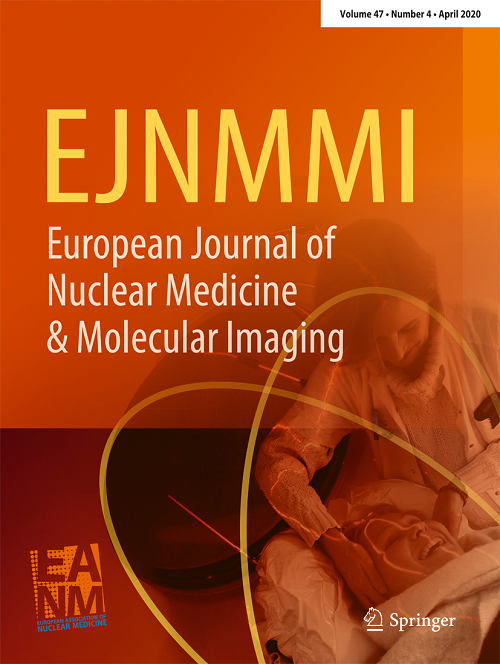Comprehensive analysis of [18F]MFBG biodistribution normal patterns and variability in pediatric patients with neuroblastoma.
IF 7.6
1区 医学
Q1 RADIOLOGY, NUCLEAR MEDICINE & MEDICAL IMAGING
European Journal of Nuclear Medicine and Molecular Imaging
Pub Date : 2025-08-15
DOI:10.1007/s00259-025-07490-x
引用次数: 0
Abstract
PURPOSE [18F]-meta-fluorobenzylguanidine ([18F]MFBG) PET/CT is a promising imaging modality for neural crest-derived tumors, particularly neuroblastoma. Accurate interpretation necessitates an understanding of normal biodistribution and variations in physiological uptake. This study aimed to systematically characterize the physiological distribution and variability of [18F]MFBG uptake in pediatric patients to enhance clinical interpretation and differentiate normal from pathological uptake. METHODS We retrospectively analyzed [18F]MFBG PET/CT scans from 169 pediatric neuroblastoma patients, including 20 in confirmed remission, for detailed biodistribution analysis. Organ uptake was quantified using both manual segmentation and deep learning(DL)-based automatic segmentation methods. Patterns of physiological uptake variants were categorized and illustrated using representative cases. RESULTS [18F]MFBG demonstrated consistent physiological uptake in the salivary glands (SUVmax 9.8 ± 3.3), myocardium (7.1 ± 1.7), and adrenal glands (4.6 ± 0.9), with low activity in bone (0.6 ± 0.2) and muscle (0.8 ± 0.2). DL-based analysis confirmed uniform, mild uptake across vertebral and peripheral skeletal structures (SUVmean 0.47 ± 0.08). Three physiological liver uptake patterns were identified: uniform (43%), left-lobe predominant (31%), and marginal (26%). Asymmetric uptake in the pancreatic head, transient brown adipose tissue activity, gallbladder excretion, and symmetric epiphyseal uptake were also recorded. These variants were not associated with structural abnormalities or clinical recurrence and showed distinct patterns from pathological lesions. CONCLUSION This study establishes a reference for normal [18F]MFBG biodistribution and physiological variants in children. Understanding these patterns is essential for accurate image interpretation and the avoidance of diagnostic pitfalls in pediatric neuroblastoma patients.[18F]小儿神经母细胞瘤患者MFBG生物分布、正常模式和变异性的综合分析。
[18F]-间氟苯基胍([18F]MFBG) PET/CT是一种很有前途的神经嵴源性肿瘤成像方式,尤其是神经母细胞瘤。准确的解释需要理解正常的生物分布和生理摄取的变化。本研究旨在系统表征儿科患者[18F]MFBG摄取的生理分布和变异性,以加强临床解释并区分正常摄取与病理摄取。方法回顾性分析169例小儿神经母细胞瘤患者的MFBG PET/CT扫描结果[18F],其中20例确诊缓解,并进行详细的生物分布分析。采用人工分割和基于深度学习(DL)的自动分割方法对器官摄取进行量化。对生理摄取变异的模式进行了分类,并使用代表性病例进行了说明。结果[18F]MFBG在唾液腺(SUVmax 9.8±3.3)、心肌(7.1±1.7)和肾上腺(4.6±0.9)中表现出一致的生理摄取,在骨(0.6±0.2)和肌肉(0.8±0.2)中表现出低活性。基于dl的分析证实了均匀、轻度的椎体和周围骨骼结构摄取(SUVmean 0.47±0.08)。确定了三种生理肝脏摄取模式:均匀(43%),左叶主要(31%)和边缘(26%)。胰腺头部的不对称摄取,短暂的棕色脂肪组织活动,胆囊排泄和对称的骨骺摄取也被记录下来。这些变异与结构异常或临床复发无关,并表现出与病理病变不同的模式。结论本研究为儿童正常[18F]MFBG生物分布及生理变异提供了参考。了解这些模式对于准确的图像解释和避免儿童神经母细胞瘤患者的诊断陷阱至关重要。
本文章由计算机程序翻译,如有差异,请以英文原文为准。
求助全文
约1分钟内获得全文
求助全文
来源期刊
CiteScore
15.60
自引率
9.90%
发文量
392
审稿时长
3 months
期刊介绍:
The European Journal of Nuclear Medicine and Molecular Imaging serves as a platform for the exchange of clinical and scientific information within nuclear medicine and related professions. It welcomes international submissions from professionals involved in the functional, metabolic, and molecular investigation of diseases. The journal's coverage spans physics, dosimetry, radiation biology, radiochemistry, and pharmacy, providing high-quality peer review by experts in the field. Known for highly cited and downloaded articles, it ensures global visibility for research work and is part of the EJNMMI journal family.

 求助内容:
求助内容: 应助结果提醒方式:
应助结果提醒方式:


